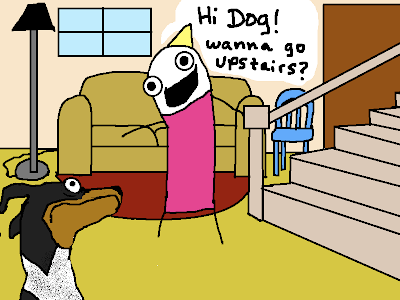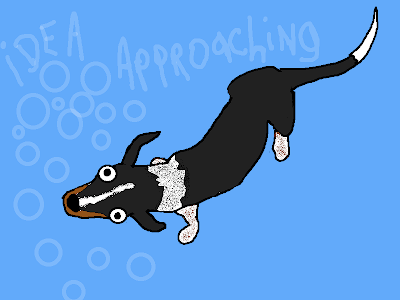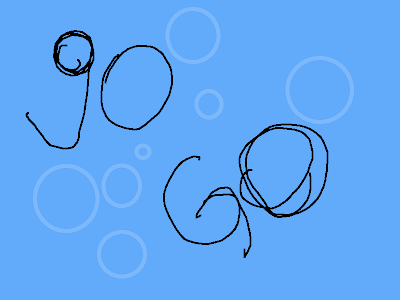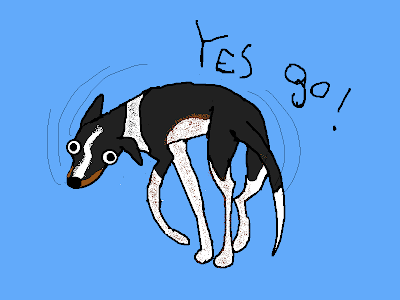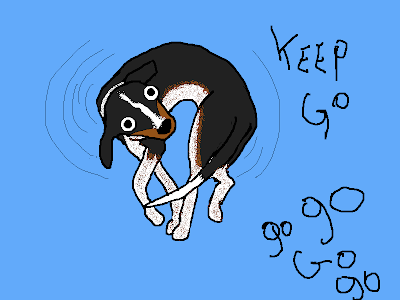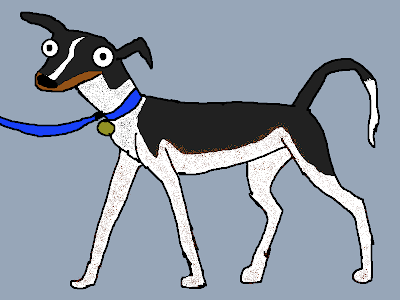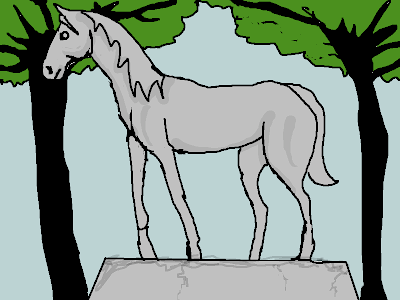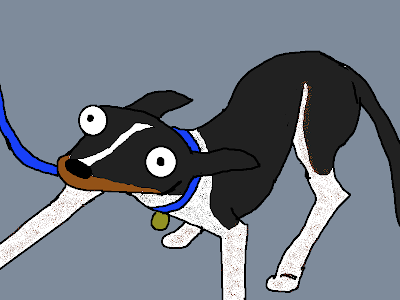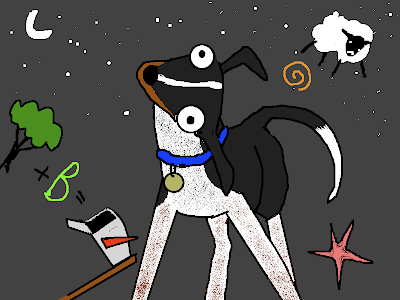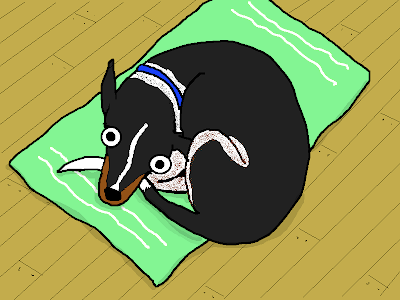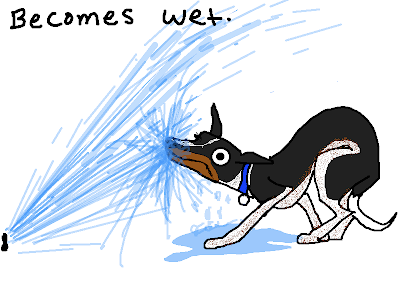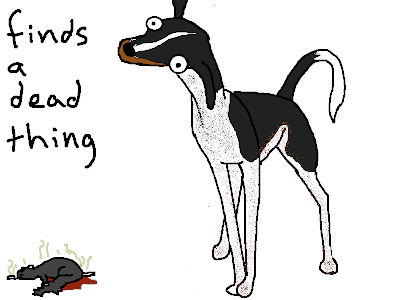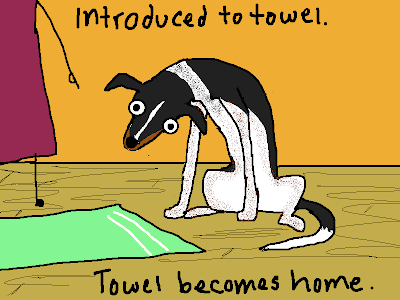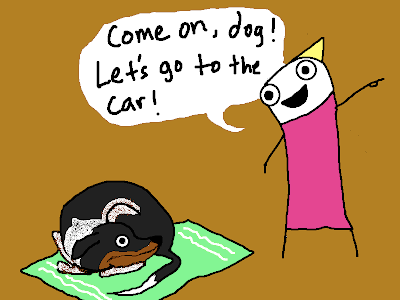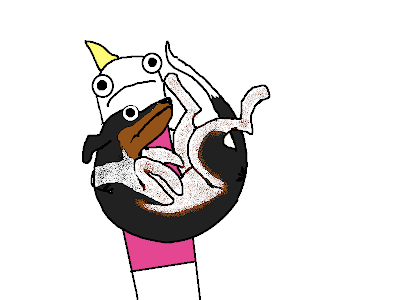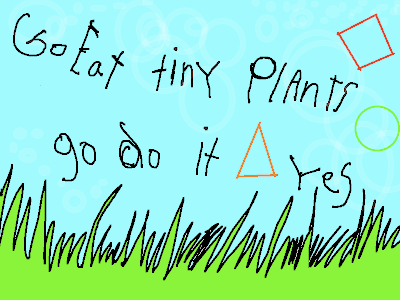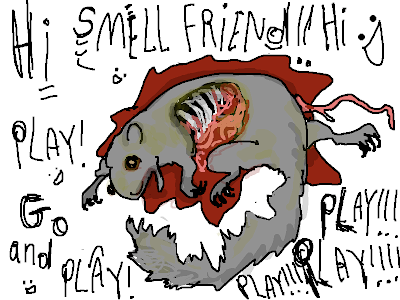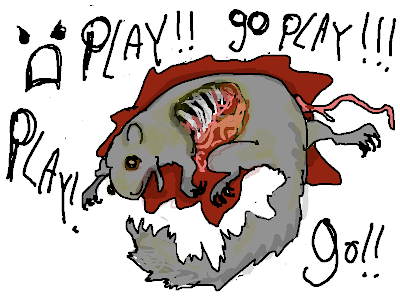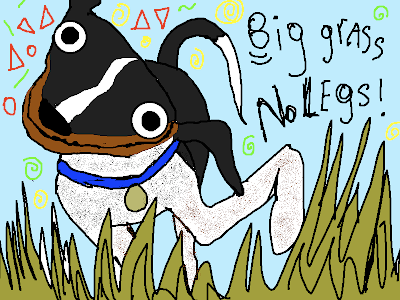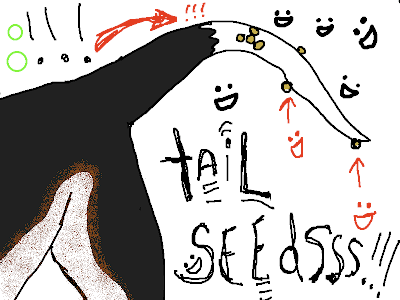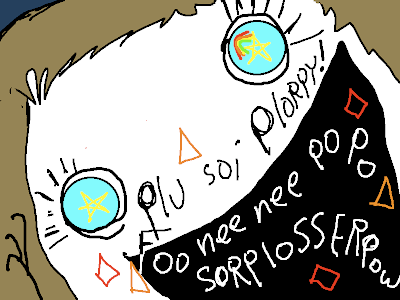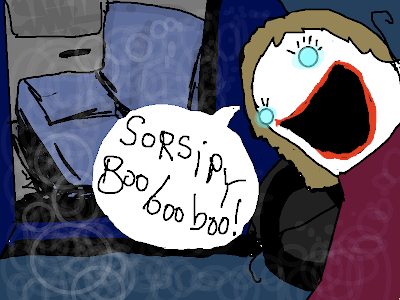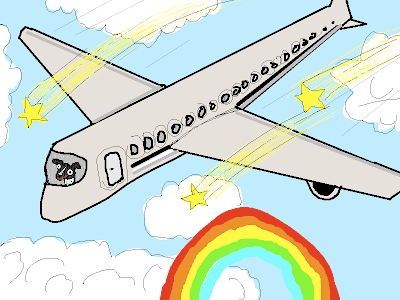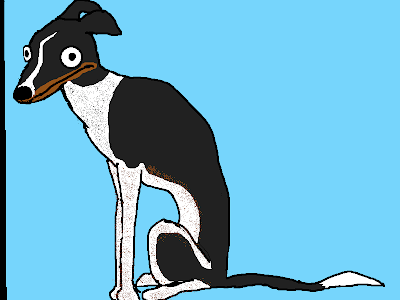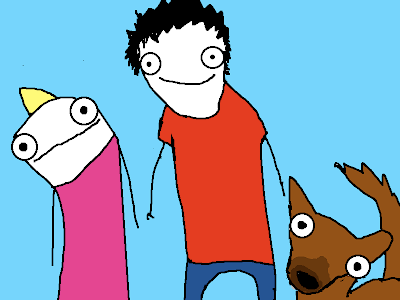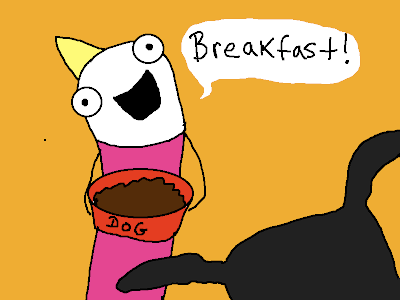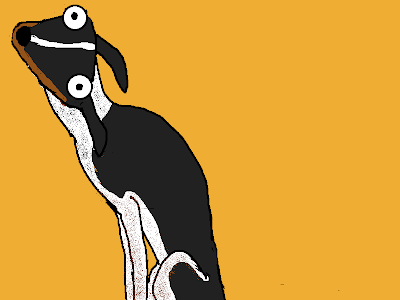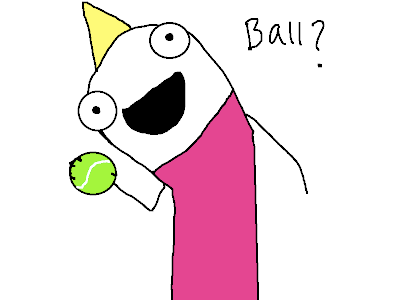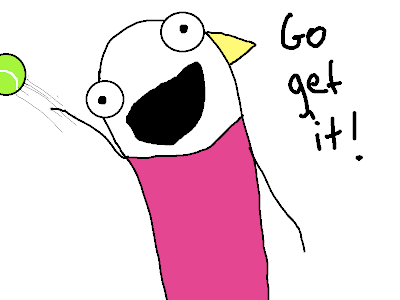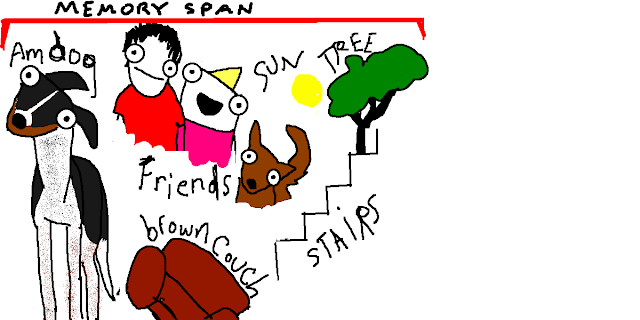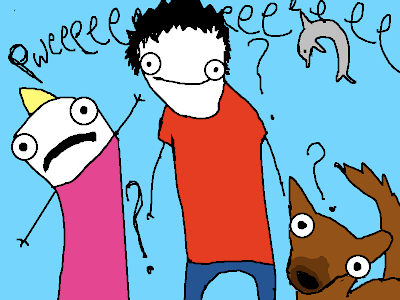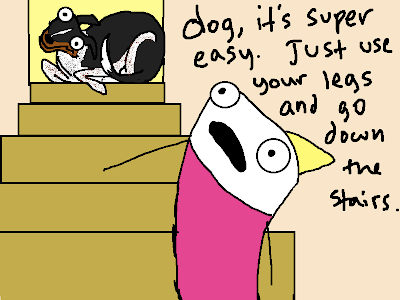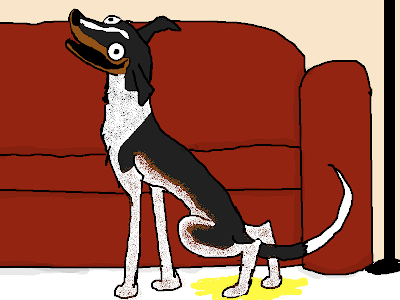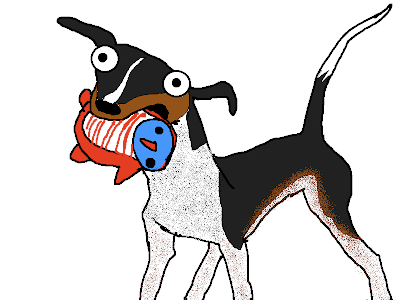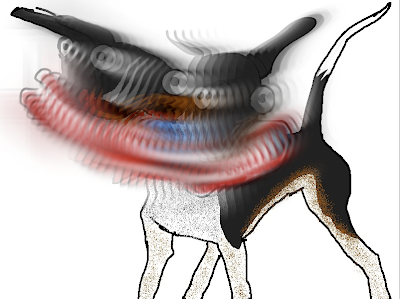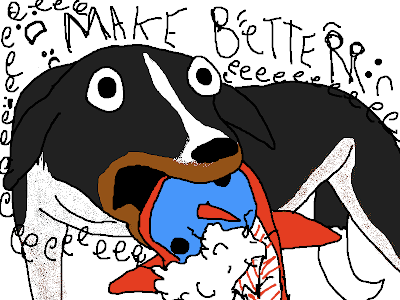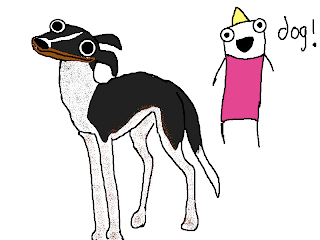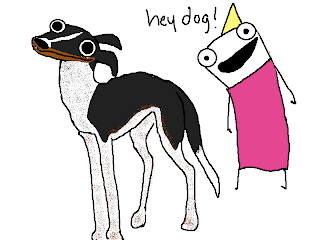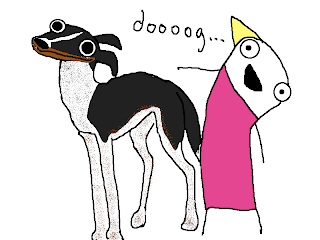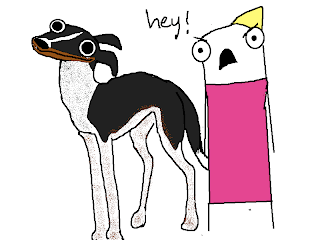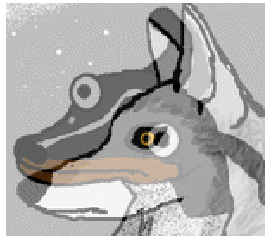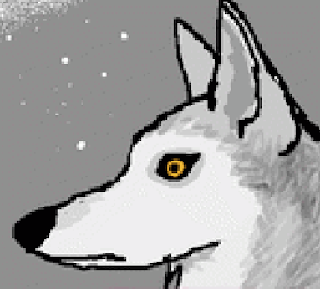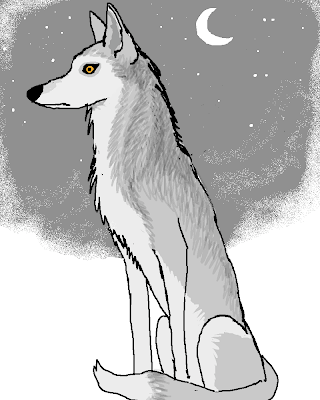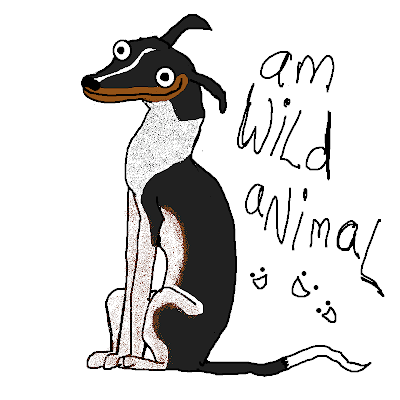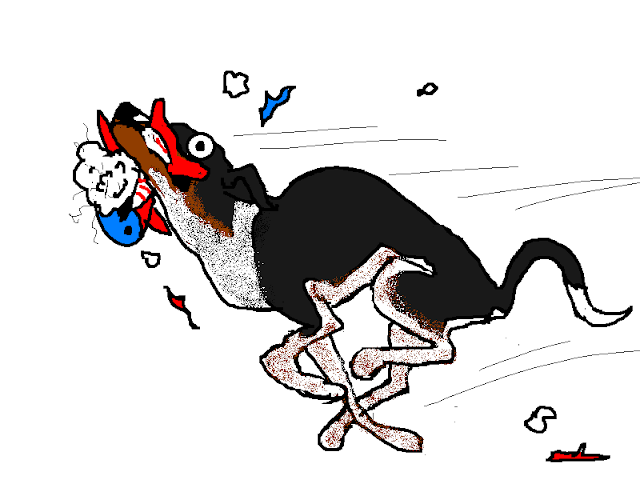Wild Animal (The Simple Dog Goes for a Joy Ride)
My simple-minded dog recently went on an unplanned adventure. Because the simple dog is so very simple, her adventure was alarming and horrible for everyone involved.
Even in her normal, familiar environment, the simple dog exists in a state of almost constant confusion.
She also appears to have very little control over what she is doing or why she is doing it. For example, the other day, she was standing in the middle of the room just staring vacantly. Then she started turning in circles like she was preparing to lie down.
But instead of completing a few rotations and then lying down like a normal dog, she got stuck in the repetitive motion and couldn't stop turning slowly in place.
She is definitely not the type of animal that would thrive in the wild.
Unfortunately, she managed to escape one day while we were out walking, and she very nearly became a wild animal.
In the park where we were walking, there is a large horse statue. We had passed the statue many times without incident, but for some reason, on that day, the simple dog became highly alarmed by it.
No one expects their dog to instantaneously develop an extremely specific fear of horse statues, and I was unprepared for her reaction, which was to sprint powerfully in the opposite direction. Unfortunately, what the simple dog lacks in cognitive capacity, she makes up in ground speed, and her sudden fleeing yanked the leash from my hand.
I chased her all the way across the park and into an adjacent neighborhood. She ran into a partially fenced yard and, when her forward trajectory was interrupted by the fence, she began to gallop in giant, crazy circles just out of my reach.
I'm fairly certain she had already forgotten what she was running from and had no idea what was going on, but there she was - propelling herself in endless loops around someone else's yard.
After several minutes of tearing around in circles, she felt compelled to take off running in a straight line. She didn't know where she was going, but she was going to go there really fast.
I have spent a truly impressive amount of time teaching the simple dog how to respond to her name. I distinctly remember the self-congratulatory feelings I had when I thought I'd succeeded. I've done it, I thought. I've overcome all of the obstacles and taught this animal her name, and now she will return to me like a falcon whenever I beckon her.
But as I watched my dog disappear into the distance, I realized just how futile my efforts had been.
I spent the rest of the day frantically trying to find her. I drove around calling for her on the off-chance that she would actually respond. I stopped random people on the street to ask them if they'd seen her. It started to get dark and I imagined my poor dog, lost and scared - completely unable to make sense of what was happening to her.
Finally, I got a call from a woman who had managed to catch the simple dog. The woman said that she found the simple dog standing in the middle of the road, wagging her tail and barking at cars. She gave me her address and I drove over to collect my wayward animal.
When I got there, the simple dog was curled up in a little ball on a towel on the woman's floor. I walked over to her and she looked confused.
She had forgotten who I was. She thought she lived on the towel.
She was wet and dirty and she stunk like she had rolled on a dead animal. There were burrs in her tail. She had puked up a pile of half-digested grass onto the woman's nice wood floor and was attempting to re-ingest it.
Based on the evidence, her adventure went something like this:
I helped the woman clean up the mess that my disgraceful animal had created in her home, then I thanked her and called my dog to go.
The simple dog did not respond, so I picked her up and carried her out.
I was glad to have her back, even though she didn't know who I was. I couldn't blame her for forgetting. A dog who becomes terrified by the mere existence of a stone rendering of a horse is not a dog who is well-prepared to absorb hundreds of unfamiliar sights and sounds, and I reasoned that she was most likely still in shock. I can only imagine how overwhelming the whole ordeal must have been from her perspective:
Perhaps unsurprisingly, the simple dog had trouble readjusting to being at home in the aftermath of her big adventure.
Because of her cognitive handicap, the simple dog is at a unique disadvantage when it comes to coping with minor obstacles that most dogs would take in stride. For most dogs, getting a taste of freedom wouldn't be something that would cause a major shift in their perception of reality. But it absolutely ruined the simple dog.
She had only been outside by herself for a few hours, but the staggering amount of new experiences had crowded out all her memories from before the adventure.
As far as the simple dog was concerned, she had been snatched away from her life as a wild, towel-dwelling animal and transplanted to a strange wonderland filled with terrifyingly unfamiliar sensory bombardments.
We have experienced these episodes a few times before. From what I understand, they are a pretty normal consequence of disabled-dog-husbandry, and are usually pretty fleeting. But this one was different. This time, the precipitating incident had been so extremely, entirely mind-bending that the simple dog had actually forgotten how to be a domesticated animal.
We had to teach her how to use the stairs all over again.
Despite having been potty-trained for the overwhelming majority of her life, she started blatantly soiling the carpet right in front of us, as if she had no idea she was doing anything wrong.
She violently destroyed every toy she had - even her inexplicably-patriotic-themed squeaky owl toy, which is her favorite.
And after she destroyed her owl, she grieved. And we had to sew it up for her to avoid pushing her any further into psychosis.
She forgot her name and how to sit and all of the various other things we'd spent so many hours carefully guiding her to understand.
We did eventually manage to re-domesticate the simple dog. She re-learned stairs and how to not pee in the house and how to respond properly when her name is called. She may not remember exactly who we are, but she seems to accept that she lives with us now. She even plays nicely with her toys.
But every now and then, she will stare wistfully out the window.
And through the window, she will see the outdoors.
And sometimes, when the shapes of the trees and grass and birds hit her brain in just the right way, she will feel the call of the wild deep within her soul.
And it will trigger a relapse.
Google is releasing Wednesday an update to Google Docs that upgrades comments and adds simple e-mail notifications by mentioning e-mail addresses in comments.
Google Docs already had basic commenting functions, but the new features make the collaboration experience more robust. Google last year added advanced collaboration tools to Docs, with a sidebar for discussing work on individual documents.
Comments now include timestamps and profile pictures. Google also added new editing features for individual comments, especially the ability to resolve comments. Rather than delete comments in an existing doc, users can remove them from visibility by resolving them. These comments are still accessible via the “discussions” button at the top of the document page.
The other interesting addition to comments is the implementation of e-mail notifications via @mentions. Just like the Twitter or Facebook @mention, users can now add others to a discussion just by @mentioning his or her e-mail address.


Say a person wants to bring a client into a document discussion. All she has to do is type something like “@ben@mashable.com Can you check this out and make sure you’re OK with the changes?” That person will receive an e-mail notification with the comment of the text. He can then add his own comments, either by commenting from the document or simply replying to the e-mail notification.
The addition of e-mail notifications via @mentions is a clever tactic by Google to bring more people into the Docs ecosystem. People who wouldn’t normally use Google Docs will be exposed to Google’s alternative to Microsoft Office. It also makes Google Docs an even better collaboration tool when a team needs to hammer out an important proposal from halfway across the world.

Here’s an interesting historical anecdote from Karl Fogel’s Producing Open Source Software on the value of preparing for meetings.
In his multi-volume biography of Thomas Jefferson, Jefferson and His Time, Dumas Malone tells the story of how Jefferson handled the first meeting held to decide the organization of the future University of Virginia. The University had been Jefferson’s idea in the first place, but (as is the case everywhere, not just in open source projects) many other parties had climbed on board quickly, each with their own interests and agendas.
When they gathered at that first meeting to hash things out, Jefferson made sure to show up with meticulously prepared architectural drawings, detailed budgets for construction and operation, a proposed curriculum, and the names of specific faculty he wanted to import from Europe. No one else in the room was even remotely as prepared; the group essentially had to capitulate to Jefferson’s vision, and the University was eventually founded more or less in accordance with his plans.
The facts that construction went far over budget, and that many of his ideas did not, for various reasons, work out in the end, were all things Jefferson probably knew perfectly well would happen. His purpose was strategic: to show up at the meeting with something so substantive that everyone else would have to fall into the role of simply proposing modifications to it, so that the overall shape, and therefore schedule, of the project would be roughly as he wanted.
YouTube Looks for the Best Nonprofit Videos of 2010
February 18, 2011, 12:57 pm
By Cody Switzer
YouTube and See3, a video communications company, are looking for some of the best examples of videos created by nonprofits—especially those videos made on the cheap—for the fifth annual DoGooder Video Awards.
The Case Foundation will give $2,500 grants to the winners of the four categories, which include videos made by large, medium, and small nonprofits, as well as a category just for videos made by any nonprofit using a budget of under $500. Winners will also have their video featured on the YouTube homepage and will receive Flip Video camcorder equipment and free registration to the 2012 Nonprofit Technology Conference.
The last day to enter is March 2, and only videos created in 2010 are eligible in the large, medium, and small nonprofit video categories. Low-cost videos are eligible if they were made in 2010 or 2011, to encourage more nonprofits to make simple videos. Any nonprofit that enters must also be a member of YouTube’s nonprofit network.
Last year’s winners included Darius Goes West, The Wooden Floor, Canadian Cancer Society and RockForEquality.
Visit the contest’s page and take a look at the contest rules.

...The most revealing moment in either Republican response, though, came from Ryan, who, as chairman of the House Budget Committee, implicitly threatened another government shutdown, or catastrophic fiscal meltdown, if the House majority doesn’t get its way. “The president is now urging Congress to increase the debt limit,” he said with distaste, referring to the vote required possibly as soon as March to allow the Treasury to keep paying its bills. Should the House majority hold that vote hostage to its vision of the budget, it will throw the markets into turmoil and upend our still-embryonic recovery.
It tells you all you need to know about Ryan’s tilt to the right that, for all his professed disapproval of increasing the debt limit during an Obama administration, he voted to do so twice himself during the gushing deficits of the Bush years. Funny he didn’t mention that Tuesday night. It tells you all you need to know about the G.O.P.’s overall tilt to the right that not just the Tea Party is making barely veiled threats to play dangerous political games with the debt limit. Mitch McConnell and Cantor did so last weekend, as have a plethora of potential 2012 presidential candidates, from Tim Pawlenty to Gingrich. The Bachmann-Beck-Palin tail is now firmly wagging the Republican dog.
Like virtually every other week since the shellacking, the State of the Union week was another salutary one for Obama. But the state of the union itself could yet be in the hands of radicals whose eagerness to see the president fail is outstripped only by their zeal to make an ideological point, even if it forces America into default.
